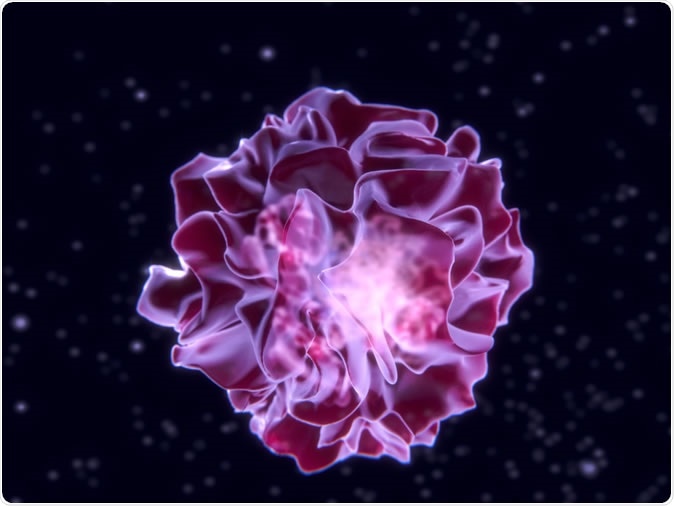A new study published on November 26, 2019, in the journal Cell Reports, details a new discovery that may help avert HIV infection right at the start. The virus is known to take a long time to infect a person, and the scientists say they have found a period during which it can be weakened or killed, in the very first hours after it has entered a host. They call this the window of vulnerability.

Dendritic cell. Dendritic cells are antigen-presenting cells of the immune system. They process antigen material and present it on the cell surface to the T cells of the immune system. 3D Rendering - Illustration Credit: Juan Gaertner / Shutterstock
Prevalence of HIV
Scientists estimate that about 1.7 million people contract the deadly HIV infection every year, all over the world. These individuals must either look forward to developing AIDS and die a miserable, lingering death of infection or cancer, or to a life of antiretroviral therapy (ART) to control the disease and live a life that is relatively normal. At present, the world has about 40 million people living with HIV (PLWH). Only about 22 million of them can take ART for various reasons.
Even for those on ART, the drugs fail to reach the heart of the disease – the actual immune cells where the virus lurks for years, to pounce upon the victim when opportunity presents itself. These drugs also have long-term side effects that may harm the patient.
HIV research consumes enormous amounts of time, funds and energy. While it has brought about a steady improvement in HIV treatment and survival, the virus has kept its secrets to itself, preventing the development of a definitive cure or vaccine.
HIV and the immune system
Once the HIV virus enters the body, it proliferates locally at the site of entry. This occupies the initial period immediately following viral invasion, only after which does systemic spread occur. This is the window of vulnerability, where the virus is limited in numbers, inefficient in spread, and concentrated mostly on multiplying itself within the host cells at the site of invasion.
Meanwhile, the white cells in the host are rushing to the defence, beginning with the phagocytes, lymphocytes, and granulocytes that offer a highly effective primary barrier. Within the phagocyte category there is a specialized subtype called plasmacytoid dendritic cells (PDCs). These are the armed patrols that constantly move through the body to detect any pathogen and set an instant antiviral immune response into action. Their name comes from the fact that as soon as they identify an intruder, they change from their normal small round shape into a more elongated shape with branch-like projections called dendrites. They also begin to churn out interferons, cell signaling molecules that act as emergency distress signals to recruit other cells and tell them to stand alert for signs of attempted invasion.
HIV neutralized natural immune barrier
The advantage this virus has over many others is its affinity for certain molecules that act as receptors to open the way into specific immune cells themselves. This weakens the body’s own defences, and the person eventually cannot resist the smallest and weakest disease-causing organism, allowing it to cause havoc. The first step in this process is to target PDCs directly. While the virus cannot kill them, it somehow causes a dramatic disappearance of these cells from the invasion site as well as from the rest of the body. With the sentries out of the way, the body doesn’t get any warning of the insidious but deadly infiltration by the HIV virus.
The experiment
The scientists wondered what would happen if they intervened on the side of the host in this ‘armed conflict’ between the HIV intruder and the body. They devised an experimental setup involving humanized mice (mice that have been modified to have a human immune system instead of the murine form). This ensures that the HIV virus will behave in the mouse as in a human.
They decided to increase the number of PDCs as well as enhance their functions, before introducing the virus and during virus invasion. This was done using a custom ligand called Flt3 receptor ligand, a protein that promotes PDC production within the bone marrow.
The findings
After administering the ligand, PDC levels remained high in HIV-infected mice. The outcomes of this high level of PDCs included:
- A lower number of mice were infected successfully
- The HIV took a longer period to rise to detectable levels in blood
- The viral load in the blood (viremia) was significantly lowered by up to a hundred times
All these findings pointed to one conclusion: maintaining a high PDC level caused suppression of the initial infection.
Additionally, this important research work shows that the Flt3 receptor ligand succeeds in increasing PDC number, increases their capability to detect the invading virus in the early phase, and stimulates interferon production once the virus is detected.
Implications
In most patients, HIV infection is a quiet process, and the infection is detected only late in the illness unless routine regular screening is done. Against this background, the study shows that it is possible to design a vaccine that could prevent virus infection within the window of vulnerability, and perhaps even to cure the disease.
Researcher Eric A. Cohen says, “These new findings will be crucial in the design of an HIV vaccine, which is basically aimed at teaching the immune system to defend itself by introducing it to a weakened form of the virus. We can now focus on PDCs in order to control the seeding and expansion of the virus at the early stage of infection.”
Source:
Journal reference:
Flt3L-Mediated Expansion of Plasmacytoid Dendritic Cells Suppresses HIV Infection in Humanized Mice Pham, Tram N.Q. et al. Cell Reports, Volume 29, Issue 9, 2770 - 2782.e5, https://www.cell.com/cell-reports/fulltext/S2211-1247(19)31416-0